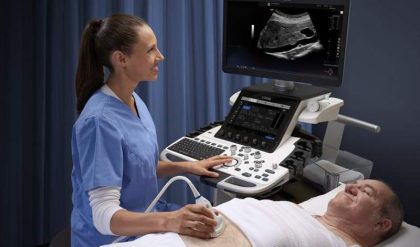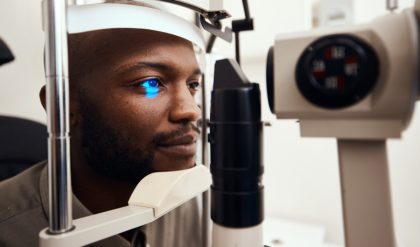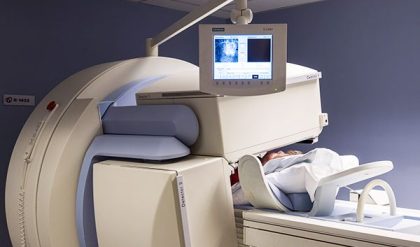The nuclear reactor which produces molybdenum-99 has a half-life of 66 hours and decays to technetium-99m. Drytec™ is a technetium-99m generator: each eluate of the generator should not contain more than 0.0056 MBq of molybdenum-99 per 37 MBq of technetium-99m per administered dose, at the time of administration. Also, the RadioGenix® System is a technetium-99m generator used to produce sodium pertechnetate 99mTc injection. The new TechneLite generator, which is the first technetium-99m generator in the United States containing molybdenum-99 (99Mo) which is produced from at least 95 percent low-enriched uranium. This new type of generator aims to eliminate the use of highly enriched uranium, which is sourced from 99Mo. Technetium-99m; is used in SPECT imaging; for example, myocardial perfusion imaging to detect coronary artery disease.
In diagnostic medicine, there is a tendency towards using more cyclotron-produced isotopes such as fluorine-18 because PET and PET-CT have become more widely available. For PET imaging, the imaging agent 2-deoxy-2-[18F]fluoro-glucose with a half-life of approximately two hours is the primary radiotracer used in nuclear medicine procedures. FDG can be incorporated into the cell without being broken down and is, therefore, a good indicator of cell metabolism.
However, the procedure needs to be completed within two hours reach of a cyclotron, which limits its utility compared with 99Mo/99m generators. For PET imaging, strontium-82, which has a half-life of 25 days, can be used to generate rubidium-82, making it more accessible.
Reactor Radioisotopes
| Radioisotope | Half-Life | Medical Applications |
| Bismuth-213 | 46 min | Used in Targeted Alpha Therapy (TAT) in the treatment of cancers: can produce high energy (8.4 MeV) particles. |
| Caesium-131 | 9.7 d | Emits soft x-rays and can be used in brachytherapy. |
| Caesium-137 | 30 yr | Used in the sterilisation of blood products. |
| Chromium-51 | 28 d | Used in the radiolabelling of red blood cells and to quantify gastrointestinal protein loss or bleeding. |
| Cobalt-60 | 5.27 yr | The high-specific-activity 60Co is used for brain cancer treatment and external beam radiotherapy is used for sterilisation. |
| Dysprosium-165 | 2 h | Used in the treatment of arthritis. |
| Erbium-169 | 9.4 d | Used to relieve arthritis pain in synovial joints. |
| Holmium-166 | 26 h | In development to diagnose and treat liver tumours. |
| Iodine-125 | 60 d | Used in brachytherapy to treat prostate cancer and brain tumours.Also, used to investigate the filtration rate of kidneys and to diagnose deep vein thrombosis in the leg. |
| Iodine-131 | 8 d | This strong gamma emitter radioisotope is used in the treatment of thyroid cancer. It is also used to image the thyroid and to investigate abnormal liver function, renal blood flow and problems with the urinary tract. |
| Iridium-192 | 74 d | This strong beta emitter radioisotope is used as a wire in high dose-rate brachytherapy for cancer treatment, especially prostate cancer. |
| Iron-59 | 46 d | To investigate iron metabolism in the spleen. |
| Lead-212 | 10.6 h | Used in Targeted Alpha Therapy to treat cancers and alpha radioimmunotherapy. The radioisotope produces the alpha-emitting products 212Bi and 212Po during the decay process. This approach is used to treat melanoma, breast and ovarian cancers. |
| Lutetium-177 | 6.7 d | Lutetium-177 emits gamma radiation for imaging, and the beta particles are used for therapy to treat endocrine tumours. |
| Molybdenum-99 | 66 h | Molybdenum-99 is used in a generator to produce technetium-99m. |
| Palladium-103 | 17 d | This radionuclide emits low energy x-rays and is used in brachytherapy in seed form to treat the early stage of prostate cancer. |
| Phosphorus-32 | 14 d | This beta emitter is used in the treatment of excess red blood cells. |
| Potassium-42 | 12 h | Potassium-42 is used to evaluate the level of exchange of potassium in coronary blood flow. |
| Radium-223 | 11.4 d | Radium-223 is used in targeted alpha brachytherapy of skeleton bone by emitting soft x-rays |
| Rhenium-186 | 3.8 d | This radioisotope is a beta emitter and produces weak gamma radiation for imaging. In therapy, it is used to treat bone cancer. |
| Rhenium-188 | 17 h | Rhenium-188 is used in conjunction with angioplasty to irradiate the coronary arteries with beta particles. |
| Samarium-153 | 47 h | Samarium-153 is a beta emitter and used in the treatment of secondary bone cancers. It is also shown to be very useful in the treatment of prostate and breast cancer. |
| Selenium-75 | 120 d | Methionine containing selenium-75 is used to investigate the production of digestive enzymes. |
| Sodium-24 | 15 h | Sodium-24 is used to study the electrolytes within the body. |
| Strontium-89 | 50 d | This radionuclide emits beta particles and helps to reduce the pain relating to prostate and bone cancer. |
| Technetium-99m | 6 h | Technetium-99m is the corresponding metastable nuclear isomer of technetium-99 and is produced from the 99Mo generator. It is the most common radioisotope for diagnosis and accounts for over 80% of scans. It is used to image heart muscle and skeleton. It also has imaging applications regarding the brain, thyroid and perfusion and ventilation of the lungs. In addition to the spleen, liver and the filtration rate of the kidneys. Other applications include the gall bladder, bone marrow, salivary and lacrimal glands. |
| Thorium-227 | 18.7 d | Thorium-227 is used in targeted alpha therapy and decays to 223Ra. |
| Xenon-133 | 5 d | Xenon-133 is used to investigate lung function. |
| Ytterbium-169 | 32 d | Ytterbium-169 is used to study the cerebrospinal fluid in the brain. |
| Ytterbium-177 | 1.9 h | Irradiation of 176Yb to give 177Yb which decays to 177Lu. |
| Yttrium-90 | 64 h | The pure beta emitter, yttrium-90 is used for cancer brachytherapy and to relieve the pain of arthritis in the synovial joints. It is also used for the treatment of liver cancer. |
| Actinium-225 | 10 d | Used in targeted alpha therapy to treat prostate cancers. |
| Astatine-211 | 7.2 h | Astatine-211 has applications in targeted alpha therapy. |
| Bismuth-213 | 46 min | Bismuth-213 has applications in targeted alpha therapy. |
| Carbon-11Nitrogen-13Oxygen-15Fluorine-18 | 20 mins10 mins2 mins110mins | These short-lived radioisotopes are used in PET imaging to study the brain, especially epilepsy and dementia. They are also used to investigate cardiac function and for the detection of cancers by using the radiotracer FDG. |
| Cobalt-57 | 272 d | Cobalt-57 is used as a marker to evaluate the size of organs and for in-vitro diagnostic kits. |
| Copper-64 | 13 h | Copper-64 has found applications in the PET imaging of tumours and cancer therapy. It is also used to study copper metabolism and Wilson’s and Menke’s diseases. |
| Copper-67 | 2.6 d | A beta emitter used in therapy. |
| Gallium-67 | 78 h | Gallium-67 is used to image tumours and inflammatory lesions. |
| Gallium-68 | 68 min | Gallium-68 is a positron emitter used in PET and PET-CT imaging. It is generated from germanium-68. |
| Germanium-68 | 271 d | Germanium-68 is used to produce 68Ga. |
| Indium-111 | 2.8 d | This radioisotope is used to study brain function, infection and the colon. It is used for the locating blood clots, inflammation and rare cancers. |
| Iodine-123 | 13 h | This gamma emitter is used to investigate thyroid function. |
| Iodine-124 | 4.2 d | This PET radiotracer is used to image the thyroid. |
| Krypton-81m | 13 s | This radioactive gas is used for investigating lung function, especially in patients with asthma. |
| Rubidium-82 | 1.26min | Rubidium-82 is a PET radiotracer used in myocardial perfusion imaging. |
| Strontium-82 | 25 d | Strontium-82 is used to generate 82Rb. |
| Thallium-201 | 73 h | Thallium-201 is used in SPECT imaging to diagnose coronary artery disease, including heart muscle death. It is also used for cardiac-stress tests. |
| FDA Approved Radiopharmaceuticals |
| Carbon-11 choline |
| Carbon-11 choline is a PET imaging agent used to evaluate prostate cancer recurrence in patients based on elevated blood prostate-specific antigen (PSA) levels. This imaging agent is used in conjunction with bone scintigraphy, computerised tomography (CT) and/or magnetic resonance imaging to identify potential sites of prostate cancer recurrence. |
| Carbon-14 urea (Pytest) |
| This radiotracer is used to help in the diagnosis of Helicobacter pylori infection in the stomach by detecting levels of gastric urease. |
| Fluorine-18 florbetaben (Neuraceq™) |
| The PET imaging agent fluorine-18 florbetaben is used to evaluate β-amyloid neuritic plaque density in the brain to aid in the diagnosis of Alzheimer’s disease. |
| Fluorine-18 florbetapir (Amyvid™) |
| Fluorine-18 flucicovine (Axumin™) |
| This diagnostic PET imaging agent is used to evaluate suspected prostate cancer recurrence based on elevated blood prostate-specific antigen (PSA) levels following treatment. |
| Fluorine-18 sodium fluoride |
| Used in PET bone imaging to determine osteogenesis imperfecta (OI) known as brittle bone disease. |
| 2-deoxy-2-[18F]fluoro-glucose (FDG) |
| The PET imaging agent 2-deoxy-2-[18F]fluoro-glucose is used to evaluate abnormal glucose metabolism in oncology and myocardial hibernation. Also, used to indicate abnormal glucose metabolism regions in the body, for example, epileptic seizures. |
| Fluorine-18 flutemetamol (Vizamyl™) |
| Fluorine-18 flutemetamol is a PET imaging agent used to estimate the level of β amyloid neuritic plaque density in the brain, especially for Alzheimer’s disease (AD). |
| Gallium-67 citrate |
| The half-life of Gallium-67 is 78 hours. This radioisotope is administered intravenously to patients as Ga-citrate. It is used to evaluate Hodgkin’s disease, Lymphoma and Bronchogenic carcinoma. |
| Gallium-68 dotatate (NETSPOT™) |
| Gallium-68 dotatate is a PET imaging agent used to identify somatostatin receptor-positive neuroendocrine tumours (NETs) in patients. |
| Indium-111 chloride |
| Indium-111 chloride is contained in the imaging agents OncoScint(satumomab pendetide) and ProstaScint (capromab pendetide) for in vivo diagnostic imaging. Also, used in the radiolabelling of Zevalin (ibritumomab tiuxetan). |
| Indium-111 pentetate |
| Used in cisternography imaging. |
| Indium-111 oxyquinoline |
| Used for radiolabelling autologous leukocytes to detect inflammatory processes associated with abscesses or other infections. |
| Indium-111 pentetreotide (Octreoscan™) |
| Octreoscan™ is used to detect primary and metastatic neuroendocrine tumours with associated somatostatin receptors. |
| Iodine I-123 iobenguane (AdreView™) |
| Iodine I-123 iobenguane is used as a diagnostic test for primary or metastatic pheochromocytoma or neuroblastoma |
| Iodine I-123 ioflupane (DaTscan™) |
| This SPECT imaging agent is used to visualise patients with suspected Parkinson’s disease. It can also be used to differentiate essential tremor due to Parkinson’s disease. |
| Iodine I-123 sodium iodide capsules |
| These capsules are used to evaluate thyroid function. |
| Iodine I-125 human serum albumin (Jeanatope) |
| Radiolabelled albumin is used to evaluate blood and plasma volume. |
| Iodine I-125 iothalamate (Glofil-125) |
| Used to investigate glomerular filtration. |
| Iodine I-131 human serum albumin (Megatope) |
| Megatope is used to evaluate the blood and plasma volumes, including cardiac and pulmonary blood volumes and circulation times. Also used to study protein turnover and the heart, including vessel delineation. |
| Iodine-131 iobenguane (AZEDRA®) |
| Iodine-131 iobenguane is used to image locally advanced or metastatic pheochromocytoma or paraganglioma that require anticancer therapy. |
| Iodine I-131 sodium iodide (HICON™) |
| Diagnostic agent iodine-131 sodium iodide is used to evaluate thyroid function such as hyperthyroidism and treatment of cancer of the thyroid. |
| Lutetium Lu-177 dotatate (LUTATHERA®) |
| Used in the treatment of somatostatin receptor-positivegastroenteropancreatic neuroendocrine tumours (GEP-NETs). |
| Molybdenum Mo-99 generator (UltraTechneKow™ V4, DRYTEC™, Technelite®, RadioGenix™ System |
| The molybdenum-99 generator is used to produce 99mTc-sodium pertechnetate for preparation of the radiopharmaceutical. These 99mTc-SPECT imaging agents can be used to image salivary glands and the lacrimal Drainage System including the thyroid. |
| Nitrogen-13 ammonia |
| Nitrogen-13 ammonia is used in PET imaging to investigate the myocardium under rest or pharmacologic stress conditions. Also, to study myocardial perfusion and coronary artery disease. |
| Radium-223 dichloride (Xofigo®) |
| Radium-223 dichloride is used for the treatment of castration-resistant prostate cancer and bone metastases. |
| Rubidium-82 chloride (Cardiogen-82®, Ruby-Fill®) |
| Rubidium-82 chloride is a PET myocardial perfusion agent used to investigate myocardial infarction. |
| Samarium-153 lexidronam (Quadramet®) |
| Samarium-153 lexidronam is used for pain relief in patients suffering from osteoblastic metastatic bone lesions. |
| Strontium-89 chloride (Metastron™) |
| Used to relieve bone pain in patients suffering from skeletal metastases. |
| Technetium-99m bicisate (Neurolite®) |
| The SPECT imaging agent technetium-99m bicisate is used after a stroke diagnosis. |
| Technetium-99m disofenin (Hepatolite®) |
| Technetium-99m disofenin is used to diagnose acute cholecystitis. |
| Technetium-99m exametazine (Ceretec™) |
| Technetium-99m exametazine is used to detect changes in the regional cerebral perfusion of a stroke patient. Also, used to investigate internal abdominal infection and inflammatory bowel disease. |
| Technetium-99m macroaggregated albumin |
| Used in the evaluation of pulmonary perfusion. |
| Technetium-99m mebrofenin (Choletec®) |
| This SPECT imaging agent is used to image the liver and gallbladder. |
| Technetium-99m medronate (MDP-25, MDP Multidose) |
| A bone imaging agent to investigate osteogenesis. |
| Technetium-99m mertiatide (Technescan MAG3™) |
| This renal SPECT imaging agent is used for the diagnose of renal failure, congenital abnormalities and urinary tract obstruction. |
| Technetium-99m oxidronate (Technescan™, HDP) |
| A bone imaging agent to evaluate osteogenesis. |
| Technetium-99m pentetate |
| Technetium-99m pentetate is used in brain and kidney imaging. |
| Technetium-99m pyrophosphate (Technescan™, PYP™) |
| This SPECT imaging agent is used to investigate areas of altered osteogenesis in the bone. Also, used as a cardiac imaging agent to diagnose myocardial infarction. |
| Technetium-99m red blood cells (UltraTag™) |
| Technetium-99m can be used to radiolabel red blood cells to study blood pool imaging including cardiac and gastrointestinal bleeding. |
| Technetium-99m sestamibi (Cardiolite®) |
| Technetium-99m sestamibi is a SPECT imaging agent to investigate myocardial perfusion, especially in the detection of coronary artery disease. |
| Technetium-99m sodium pertechnetate |
| Technetium-99m sodium pertechnetate is used in SPECT imaging of the brain including thyroid and salivary gland imaging. Also, used in angiography and urinary bladder imaging. |
| Technetium-99m succimer |
| Used to evaluate renal parenchymal disorders. |
| Technetium-99m sulfur colloid |
| Technetium-99m sulfur colloid is used in SPECT imaging of the reticuloendothelial cells in the liver, spleen and bone marrow. It can also be used in oesophageal and gastroesophageal reflux scintigraphy. In addition to the detection of pulmonary aspiration of gastric contents and in the assessment of breast cancer or malignant melanoma. |
| Technetium-99m tetrofosmin (Myoview™) |
| Myoview is used in SPECT imaging of myocardial perfusion for detecting coronary artery disease by localising myocardial ischemia and infarction. Also, used in the assessment of left ventricular function. |
| Technetium-99m tilmanocept (Lymphoseek®) |
| Technetium-99m tilmanocept is used to map the lymphatic system for tumour sites. |
| Thallium-201 chloride |
| Thallium-201 chloride is a myocardial perfusion SPECT imaging agent used for the diagnosis and localization of myocardial infarction. |
| Xenon-133 gas |
| Xenon-133 gas is used to investigate the pulmonary function and for imaging the lungs including the assessment of cerebral flow. |
| Yttrium-90 chloride |
| Zevalin is used for radioimmunotherapy procedures. |
| Yttrium-90 ibritumomab tiuxetan (Zevalin®) |
| Yttrium-90 ibritumomab tiuxetan is used for the treatment of relapsed or refractory, low-grade or follicular B-cell non-Hodgkin’s lymphoma (NHL). |
Future of Radiopharmaceuticals
Technetium-99m and 2-deoxy-2-[18F]fluoro-glucose (FDG) remain the workhorse radiopharmaceuticals for SPECT and PET imaging accounting for 80 percent of all nuclear medicine procedures. However, several new radiopharmaceuticals are driving molecular imaging in the clinical setting, and these include the PET imaging agents flutemetamol and florbetapir which are used in the early diagnosis of neurodegenerative diseases such as Alzheimer’s. The technetium-99m radiopharmaceutical ubiquicidin is used to detect bacterial infections on the sites of orthopaedic implants extending to 68Ga-NOTA-ubiquicidin for PET imaging of infection.
Incidentally, there are some new cardiovascular PET imaging applications towards myocardial perfusion imaging such as ammonia-13 and flurpiridaz. Also, the recent approval of RUBY-FILL (generator containing strontium-82) and the elution system to produce CardioGen-82: these systems lead to the formation of rubidium-82. This radionuclide is used in the clinical setting in the form of 82RbCl to mimic the potassium ions (K+) for the imaging of myocardial perfusion. However, due to its short half-life of 1.3 min rubidium-82 poses several challenges for routine applications. However, the benefit of using rubidium-82 is that it provides a higher resolution PET scan in comparison to the SPECT tracer 99mTc-MIBI.
A novel class of PET radiopharmaceuticals using 68Ga-FAPI was able to identify at least 30 types of malignant tumours. This radiotracer targets cancer-associated fibroblasts, which can contribute up to 90 percent of a tumour’s mass.
Advancements of radiopharmaceuticals in oncology have included axumin (18F-fluciclovine) used for the detection of recurrent prostate cancer. The FDA has given approval for the PET imaging agent 68Ga-dotatate known as NETSPOT™ to locate somostatin receptor positive neuroendocrine tumours in both adult and paediatric patients.
Subsequently, the PET radiotracer, 18F-TZ3504 has been used to image neuroinflammation due to multiple sclerosis by quantitative assessment of S1P1 expression in the body.
The generation of technetium-99m introduces problems to the SPECT-CT market and therefore requires an alternative approach. The non-reactor manufacture of technetium-99m in the future will allow SPECT radiopharmaceuticals to effectively compete with cardiac PET.
Theranostics is a hot topic in the radiopharmaceutical market, especially due to the latest FDA approval of lutetium-177 dotatate (lutathera) to image and treat gastroenteropancreatic neuroendocrine tumours. This theranostic agent is a combination of a diagnostic agent and a therapeutic agent, such as 68Ga- and 177Lu-dotatate.
Another promising prostate cancer theranostic pairing are the bombesin analogues, 68Ga and 177Lu-RM2. Also, 86Y (β+) forms a theranostic isotopic pair with the pure β− emitter 90Y. Currently, the PET radiometal 44Sc which can be obtained from a 44Ti/44Sc generator possesses similar decay characteristics to 68Ga but a longer half-life of 3.97 hours. It has been demonstrated that 44Sc-DOTATOC is compatible with standard radiolabelling techniques and produces a comparable imaging quality to that of the 68Ga-DOTATOC.
In addition, the calcium mimic, Xofigo (radium-223) was approved by the FDA in 2013 for the treatment of bone metastases in prostate cancer. However, a future radiopharmaceutical [225Ac]-FPI-1434 is in development to target solid tumours, which include non-small cell lung, prostate and breast cancers.
Interestingly, pentixafor can be labelled with 99mTc for SPECT imaging and 68Ga for PET imaging. This imaging agent binds to CXC chemokine type 4 receptors which are up-regulated in several cancers, for example, multiple myeloma.
In January 2019, the diagnostic radiopharmaceutical, 64Cu-dotatate, received fast track designation from the FDA. 64Cu-dotatate is a PET diagnostic agent developed to detect neuroendocrine tumours. Also, the radiotherapy drug Azedra (iobenguane iodine-131) is used to treat rare tumours of the adrenal gland called pheochromocytomas.
On the SPECT horizon, the radiotracer AdreView (iobenguane iodine-123) is the first imaging agent to establish a link between nerve function in the heart and the patient’s mortality risk. Also, AdreView has been given FDA approval for the scintigraphic assessment of myocardial sympathetic innervation, known as cardiac nerve activity.
Currently, a new generation of hybrid scanners is entering the clinical setting which combines PET and MRI imaging. This will allow for the development of a new class of imaging agents which incorporate the radionuclide into superparamagnetic iron oxide nanoparticles (SPION) to allow hybrids of PET/MRI and SPECT/MRI.
An alternative approach is to use paramagnetic manganese instead of the MRI contrast agents based on gadolinium. It can be envisaged that the use of paramagnetic manganese and the PET radiometal 52gMn can be used to produce hybrid PET/MRI images. These scanners will enable radiopharmaceuticals to be developed to evaluate traumatic brain injury and post-traumatic stress disorder amongst other disease states.




